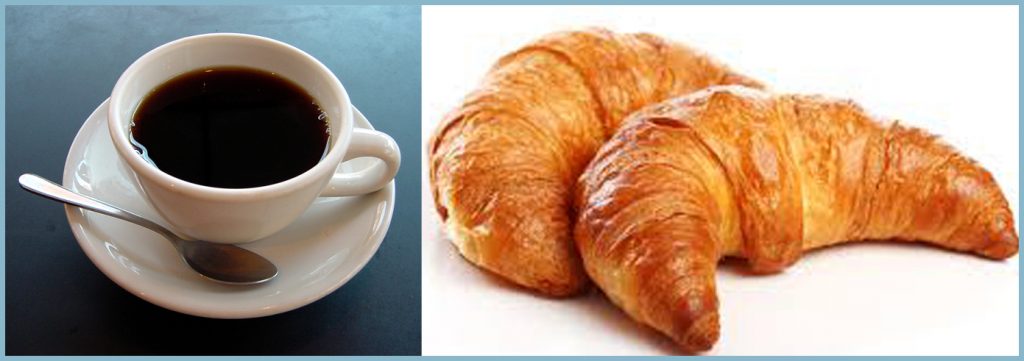
“To celebrate, the Viennese bakers made for days crescent-shaped (Turkish emblem) rolls. Later, the French adopted the practice, and christened the name from crescent to famous CROISSANT! (“croix” in French means “cross”)”
by Ayhan ÖZER
Most people love this combination, especially in the morning. How these two “divine” palate-pleasers came to be known? There is a Turkish-related history behind it. It goes back to 1683! At that time the Austrian capital Vienna was under siege by the Turks – second time! It was a major military campaign. The huge Ottoman Army marched for three months from Istanbul, first to Belgrade, a Turkish outpost at that time, and then moved to the outskirts of Vienna. On July 13, 1683 the Ottoman Army pitched its camp outskirts of Vienna in the form of a crescent.
This Turkish campaign afforded two international customs still in existence today, and they are very popular.
This Turkish campaign afforded two international customs still in existence today, and they are very popular. One of them is coffee drinking. During that siege, a Viennese man by the name George Franz Koschitsky was carrying intelligence to the Turks; and he also served coffee to the troops. The siege was protracted, because the Commander did not want to storm the City, it wanted to keep it intact, without having been plundered by the troops, so that his spoil would be much greater. The troops controlled and restricted the food supplies entering the City. The Commander expected the Viennese would soon be sick and tired, and surrendered. Yet, they held out, and they vehemently sought help from other European countries, especially from the Poles.
The siege drawn out, and the rainy season began. The Ottoman army became restless due to long idleness. In view of these adverse conditions the Turks decided to rescind the siege and go back. This huge campaign failed due to mismanagement and short-sightedness of the Commander Grand-vizir Merzifonlu Kara Mustafa Pasha. He ordered the Army to retreat to Belgrade, an interim Ottoman outpost, before marching to Istanbul. Sultan Mehmet IV did not take this failure lightly. He dispatched two executioners to Belgrade to bring the head of Kara Mustafa Pasha.
To carry all those huge coffee sacks back to Istanbul was too great a burden.
To carry all those huge coffee sacks back to Istanbul was too great a burden. So, they decided to leave them behind. Koschitsky was the only person who knew how to prepare the Turkish coffee. With this enormous supply Koschitsky opened his first coffee house in Vienna in 1683. The Viennese people tasted the Turkish coffee, and liked. Also, coffee created a social atmosphere. In coffee-houses people got together around “Kaffee-klatsch” to have coffee and conversation.
This new custom burgeoned in the City and added a new dimension to the social scene of Vienna. The next coffee house in Europe was opened in Paris in 1685. Then, the habit of coffee drinking spread to entire Europe, and took hold rapidly.
During that siege, the Turks were digging tunnels under the city walls, and the sappers did their work mostly after midnight. However, the bakers of Vienna started their work very early in the morning. In the quiet of the wee hours, they heard some dull noise coming from underground.
They got suspicious, and figured that the Turks might have been up to something, and they immediately informed their commanders. The suspicion proved correct, and the scheme foiled. Then, the Turkish Army lifted the siege, and retreated.
To celebrate, the Viennese bakers made for days crescent-shaped (Turkish emblem) rolls. Later, the French adopted the practice, and christened the name from crescent to famous CROISSANT! (“croix” in French means “cross”)
So, the Turkish siege of Vienna brought forth two important customs to the world.
_ . _

Know in France as croissants de boulanger, this yeasted dough is layered with butter and given a succession of folds that create the distinctive profile of classic croissants. Light and airy and shatteringly crisp, with a deeply caramelized buttery flavor, these croissants are a labor of love that’s absolutely worth the time.
Source:
https://www.kingarthurflour.com/recipes/bakers-croissants-recipe
Image: For Fairly Use
_ . _
https://turkishlibrary.us/coffee-and-tea-customs-in-turkey/
The U.S. Turkish Library & Museum Project is under The Light Millennium Organization, Associated with the Department of Global Communications of the United Nations (formerly #UNDPINGO).
• Commercial Free – Public Benefit E-Publication
https://turkishlibrary.us | http://www.isikbinyili.org | http://www.lightmillennium.org
Social media @lightmillennium #lightmillennium @turkishlibrarymuseum